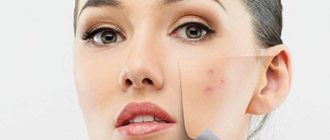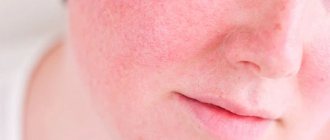Doxycycline is an antibiotic commonly prescribed for moderate to severe acne. It is also used to treat mild forms of inflammatory acne that do not respond to other treatments. To increase effectiveness and safety, doxycycline is usually combined with other acne treatments. Doxycycline is usually taken for three to four months.
Acne is a common skin condition that, if left untreated, can cause severe distress and long-term damage to the skin. Symptoms can range from mild (pimples, blackheads and whiteheads) to severe (papules, pustules and nodules). Although effective treatment can be a difficult and time-consuming task, doxycycline for acne has earned a reputation as one of the most effective acne medications available.
Description and composition of Doxycycline
Doxycycline is a synthetic antibacterial agent. The drug is prescribed to treat diseases caused by a variety of bacteria. Doxycycline for acne prevents the proliferation of pathogenic microorganisms.
The active substance has a detrimental effect on the following types of flora:
- bacteria (gram-positive, gram-negative);
- chlamydia;
- coli;
- gonococcus;
- staphylococcus;
- streptococcus.
The antibiotic is characterized by rapid absorption and distribution throughout the body, due to which a gradual elimination of acne is achieved. Elements of the drug are excreted along with waste products (urine, feces).
The composition of the antibiotic depends on the dosage form. Hard capsules contain:
- glycerol;
- gelatin;
- purified water;
- titanium dioxide;
- dyes (E 104, E 110);
- sodium lauryl sulfate;
- calcium stearate;
- potato starch;
- lactose monohydrate;
- hycladoxycycline.
Yellow tablets have a biconvex shape and are similar to capsules. There is a line mark on one side and an engraving of 173 on the other. Doxycycline monohydrate is used as the active substance.
The powdery mixture is a yellowish, clarified powder in the form of crystals. To prepare the solution, the powder is diluted in water.
Results
Doxycycline is a primary acne treatment that has been shown to effectively treat acne and is a component of the first-line treatment regimen for moderate to severe inflammatory acne.
As part of the tetracycline class, it may be superior to other antibiotics due to its antibacterial and anti-inflammatory properties.
A review of numerous clinical trials found that doxycycline successfully reduced up to 75% of inflammatory acne lesions and up to 54% of comedones (blackheads and whiteheads).
Doxycycline is not an effective treatment for acne scars because they are no longer actively inflamed.
How long does it take to get results?
Optimal combination therapy of doxycycline, benzoyl peroxide, and a topical retinoid can lead to improvement in as little as 2 weeks. However, some people may take up to 12 weeks to see improvements.
Indications for use of Doxycycline
It is known that Doxycycline is an antibacterial drug from the tetracycline group. The drug is prescribed for various diseases, which is associated with its high effectiveness. Indications for use are due to inflammatory processes of a bacterial nature:
- genitourinary system;
- respiratory tract;
- Gastrointestinal tract;
- organs of vision.
An antibiotic is prescribed to treat pustular skin lesions. The use of the drug is necessary after surgery to prevent purulent complications.
How does doxycycline work in treating acne?
Doxycycline helps treat acne in several ways. It prevents the growth of acne-related bacteria, Cutibacterium acnes (formerly Propionibacterium acnes). By inhibiting the proliferation of C. acnes, doxycycline helps restore the balance of the skin microbiome. The microbiome is the trillions of microorganisms invisible on the skin that keep skin healthy.
Doxycycline also has anti-inflammatory properties. By inhibiting certain pro-inflammatory enzymes and acting as an antioxidant, it can reduce inflammation associated with acne.
Instructions for use of Doxycycline for acne
The use of an antibiotic for acne should be as directed and under the supervision of a physician. The dosage form and dosage depend on the location and severity of acne.
Instructions for use of Doxycycline for acne indicate the need to use the drug for 5-7 days. The drug is taken 2 times a day (100 mg).
Treatment of acne with Doxycycline in children 9-14 years old is carried out according to the following scheme:
- dosage at the rate of 4 mg per 1 kg of weight twice a day (2 days);
- dose 3 mg per 1 kg of weight on the remaining days.
Adolescents over 14 years of age take Doxycycline for acne according to the following regimen:
- a dose of 200 mg once on day 1 of treatment;
- dosage, which involves taking 100 mg of the drug, 2 times a day.
Doxycycline tablets for acne should be taken 1-2 times a day. To prevent intestinal dysbiosis, it is recommended to take medications that support the gastrointestinal tract. During the period of therapy, it is advisable to increase the consumption of fermented milk products, which include kefir, fermented baked milk, yogurt or yogurt.
Acne masks based on Doxycycline
Doxycycline for acne can be used externally as a mask.
With cosmetic clay
To prepare the mask, use white or green clay, which is diluted with water to the consistency of sour cream. Add crushed antibiotic tablets (5 pieces) to the mixture and mix gently. The mask is applied to the face and washed off with warm water after 15 minutes.
With egg
The mask is suitable for dry skin. A beaten chicken egg is mixed with antibiotic powder, which is obtained from medication capsules. You need to add a teaspoon of olive oil and 10 g of starch (potato) to the mixture. After thorough mixing, the mask is applied to the affected areas of the skin and washed off after 15 minutes.
Attention! The course of treatment involves the use of two procedures over 3 weeks.
With milk
A milk mask is recommended for oily skin and acne. The contents of 2 antibiotic capsules are mixed with 20 g of flour. To obtain a thick paste, add 50 ml of milk (with a low fat content). A drop of essential oil will help enhance the effect. The mask should be applied to the acne area and washed off after 10 minutes.
The mask is applied to the face 1-2 times during the week. The course of therapy is one and a half months.
What to do at the purging stage
As with other acne medications, your symptoms may get worse in the first 4 to 6 weeks of treatment before they get better. This is called cleansing and occurs due to increased skin cell turnover and accelerated release of deep-seated comedones.
Be especially gentle with your skin at this stage to avoid further irritation. Avoid all abrasive skin care products and opt for a sulfate-free cleanser and a light moisturizer.
You should not stop taking doxycycline without consulting a professional. If symptoms persist or worsen, consult a dermatologist.
Follow a few simple rules to prevent further skin irritation during this time:
● Do not touch or break out the lesions; avoid touching your face completely to maintain good hygiene
● Avoid heavy makeup and skin care products for oily skin, which can aggravate acne.
●Change your pillowcase regularly to prevent oil and debris from getting on your face.
● Maintain your skin care routine to clear out oil buildup from your pores.
Contraindications to the use of Doxycycline
There are a number of contraindications, if identified, the use of Doxycycline is not recommended. Contraindications to taking the drug include:
- hypersensitivity reactions to the components of the drug;
- liver failure;
- liver dysfunction;
- pregnancy;
- lactation period;
- porphyria;
If contraindications to taking Doxycycline are identified, the doctor prescribes a medication with a similar therapeutic effect. Concomitant use with alcohol is prohibited.
Side effects and overdose
Doxycycline has a high degree of antibacterial activity. Taking Doxycycline for acne may cause side effects:
- nausea;
- swelling;
- vomiting;
- itching;
- rash;
- dizziness;
- anxiety;
- drowsiness;
- pain in joints and muscles.
When taking tablets and capsules, stool disorders often appear. To minimize the harmful effects of the drug on the digestive tract, the antibiotic should be taken after meals and washed down with a sufficient amount of liquid. In case of severe adverse reactions, you should consult a specialist.
Attention! Taking Doxycycline while sitting or standing reduces the risk of developing esophageal inflammation or esophagitis.
Compatibility with other drugs
The medicine is incompatible with medications that have an alkaline environment (antacids or sodium bicarbonate). You should not combine use with Erythromycin, Aminophylline or Hydrocortisone due to their instability in an acidic environment. The combined use of antibacterial agents of the tetracycline group, cephalosporins, and penicillin is not provided.
Attention! Parallel administration of Metronidazole is possible.
Reduce the absorption of the drug Cholestipol and Cholestyramine, as well as the following additives:
- calcium;
- iron.
Reduce the effectiveness of the drug due to the production of enzymes:
- Carbamazepine;
- Phenotoin;
- barbiturates;
- Rifampicin.
During treatment, the effect increases:
- Warfarin;
- Fenilina.
Attention! The effectiveness of COCs containing estrogen is reduced. There is an increased risk of bleeding.
Doxycycline analogs
Analogue drugs containing doxycycline have the same effects and side effects. The difference lies in the content of auxiliary components.
The following analogues of Doxycycline are called:
- UnidoxSolutab;
- Monocline;
- Vibramycin;
- Doxal;
- Doxibene;
- Xedocin.
Important! To treat acne, you can use external antibacterial drugs, for example, Zinerit.
What is doxycycline
Doxycycline is an oral antibiotic that belongs to a class of drugs called tetracyclines, which are broad-spectrum antibiotics. This means they can kill a wide range of bacteria, making them effective against infections such as pneumonia and chlamydia.
Doxycycline also has anti-inflammatory properties and is commonly prescribed to treat rosacea, also known as adult acne.
This antibiotic can also effectively kill infections caused by gram-positive and gram-negative bacteria.
Recommendations from dermatologists
For mild forms of the disease, the drug is not prescribed. The maximum result is achieved with long-term use of small doses of the drug (up to 3 months). This treatment regimen allows you to obtain long-term remission and reduce the harmful effects of the active substance on the body.
Treatment of acne is not a direct indication for taking Doxycycline. The tableted drug has a systemic effect on the body, which also manifests itself in a decrease in the protective functions of the immune system.
To prevent fungal infections, it is recommended to take simultaneous antifungal agents and drugs to prevent dysbacteriosis (Linex). During therapy, ultraviolet radiation should be avoided.
Doxycycline for acne is prescribed in extreme cases. First of all, it is recommended to use gentle medications, including externally, for the treatment of acne.
Interactions and side effects
It is especially important to avoid the sun and wear a protective layer of sunscreen, as doxycycline can cause skin sensitivity, leading to rashes, itching, redness and sunburn.
Some drugs may reduce the absorption of doxycycline into the body, making it less effective, including:
● Antacids.
● Certain antibiotics, such as rifampicin.
● Iron supplements and multivitamins with iron.
● Minerals and vitamins such as calcium, iron and zinc.
● Anticonvulsants such as barbiturates, carbamazepine and phenytoin.
Particular caution and monitoring should be exercised when combining doxycycline with the following drugs:
● Aminolevulinic acid (ALA) may cause an increased risk of skin reactions.
● Blood thinners such as warfarin may increase the risk of bleeding.
● Some retinoids, such as isotretinoin, can cause increased pressure in the brain.
Other drugs may also interact with doxycycline; Make sure your dermatologist knows about all the prescription and over-the-counter medications you take.
Side effects
Some common side effects may occur, including:
● Esophagitis (inflammation of the esophagus), which may result in heartburn or chest discomfort; As a preventative measure, take doxycycline with a full glass of water and do not lie down for 30 minutes afterward.
● Loss of appetite, diarrhea, nausea or vomiting
● Photosensitivity (increased susceptibility to sunburn).
● Rash.
Other side effects
Rare but more serious side effects include:
● Permanent damage to teeth and bones in children and infants when taking doxycycline during pregnancy.
● Stevens-Johnson syndrome and toxic epidermal necrolysis (TEM), severe skin reactions that cause blistering and peeling of the skin.










